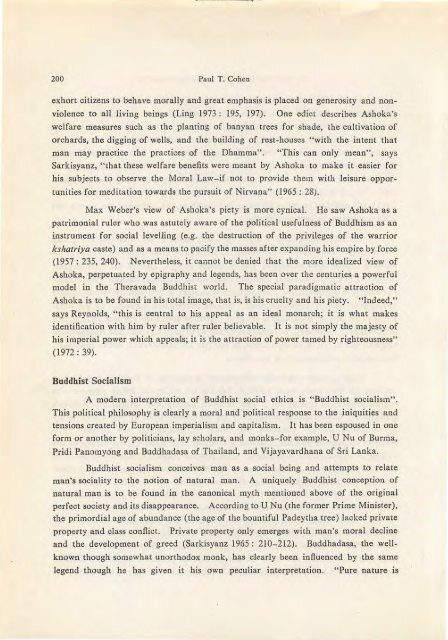The Journal of the Siam Society Vol. LXXII, Part 1-2, 1984 - Khamkoo
The Journal of the Siam Society Vol. LXXII, Part 1-2, 1984 - Khamkoo
The Journal of the Siam Society Vol. LXXII, Part 1-2, 1984 - Khamkoo
Create successful ePaper yourself
Turn your PDF publications into a flip-book with our unique Google optimized e-Paper software.
200 Paul T. Cohen<br />
exhort citizens to behave morally and great emphasis is placed on generosity and nonviolence<br />
to all living beings (Ling 1973: 195, 197). One edict describes Ashoka's<br />
welfare measures such as <strong>the</strong> planting <strong>of</strong> banyan trees for shade, <strong>the</strong> cultivation <strong>of</strong><br />
orchards, <strong>the</strong> digging <strong>of</strong> wells, and <strong>the</strong> building <strong>of</strong> rest-houses "with <strong>the</strong> intent that<br />
man may practice <strong>the</strong> practices <strong>of</strong> <strong>the</strong> Dhamma".<br />
"This can only mean", says<br />
Sarkisyanz, "that <strong>the</strong>se welfare benefits were meant by Ashoka to make it easier for<br />
his subjects to observe <strong>the</strong> Moral Law-if not to provide <strong>the</strong>m with leisure opportunities<br />
for medita tion towards <strong>the</strong> pursuit <strong>of</strong> Nirvana" (1965 : 28).<br />
Max Weber's view <strong>of</strong> Ashoka's piety is more cynical.<br />
He saw Ashoka as a<br />
patrimonial ruler who was astutely aware <strong>of</strong> <strong>the</strong> political usefulness <strong>of</strong> Buddhism as an<br />
instrument for social levelling (e.g. <strong>the</strong> destruction <strong>of</strong> <strong>the</strong> privileges <strong>of</strong> <strong>the</strong> warrior<br />
kshatriya caste) and as a means to pacify <strong>the</strong> masses after expanding his empire by force<br />
(1957 : 235, 240). Never<strong>the</strong>less, it cannot be denied that <strong>the</strong> more idealized view <strong>of</strong><br />
Ashoka, perpetua ted by epigraphy and legends, has been over <strong>the</strong> centuries a powerful<br />
model in <strong>the</strong> <strong>The</strong>ravada Buddhist world. <strong>The</strong> special paradigmatic attraction <strong>of</strong><br />
Ashoka is to be found in his total image, that is, is his cruelty and his piety.<br />
"Indeed,"<br />
says Reynolds, "this is central to his appeal as an ideal monarch; it is what makes<br />
identification with him by ruler after ruler believable. It is not simply <strong>the</strong> majesty <strong>of</strong><br />
his imperial power which appeals; it is <strong>the</strong> attraction <strong>of</strong> power tamed by righteousness"<br />
(1972: 39).<br />
Buddhist Socialism<br />
A modern interpretation <strong>of</strong> Buddhist social ethics is "Buddhist socialism".<br />
This political philosophy is clearly a moral and political response to <strong>the</strong> iniquities and<br />
tensions created by European imperialism and capitalism.<br />
It has been espoused in one<br />
form or ano<strong>the</strong>r by politicians, lay scholars, and monks-for example, U Nu <strong>of</strong> Burma,<br />
Pridi Panomyong and Buddhadasa <strong>of</strong> Thailand, and Vijayavardhana <strong>of</strong> Sri Lanka.<br />
Buddhist socialism conceives man as a social being and attempts to relate<br />
man's sociality to <strong>the</strong> notion <strong>of</strong> natural man. A uniquely Buddhist conception <strong>of</strong><br />
natural man is to be found in <strong>the</strong> canonical myth mentioned above <strong>of</strong> <strong>the</strong> original<br />
perfect society and its disappearance. According to U Nu (<strong>the</strong> former Prime Minister),<br />
<strong>the</strong> primordial age <strong>of</strong> abundance (<strong>the</strong> age <strong>of</strong> <strong>the</strong> bountiful Padeytha tree) Jacked private<br />
property and class conflict. Private property only emerges with man's moral decline<br />
and <strong>the</strong> development <strong>of</strong> greed (Sarkisyanz 1965: 210-212). Buddhadasa, <strong>the</strong> wellknown<br />
though somewhat unorthodox monk, has clearly been influenced by <strong>the</strong> same<br />
legend though he has given it his own peculiar interpretation.<br />
"Pure nature is

















